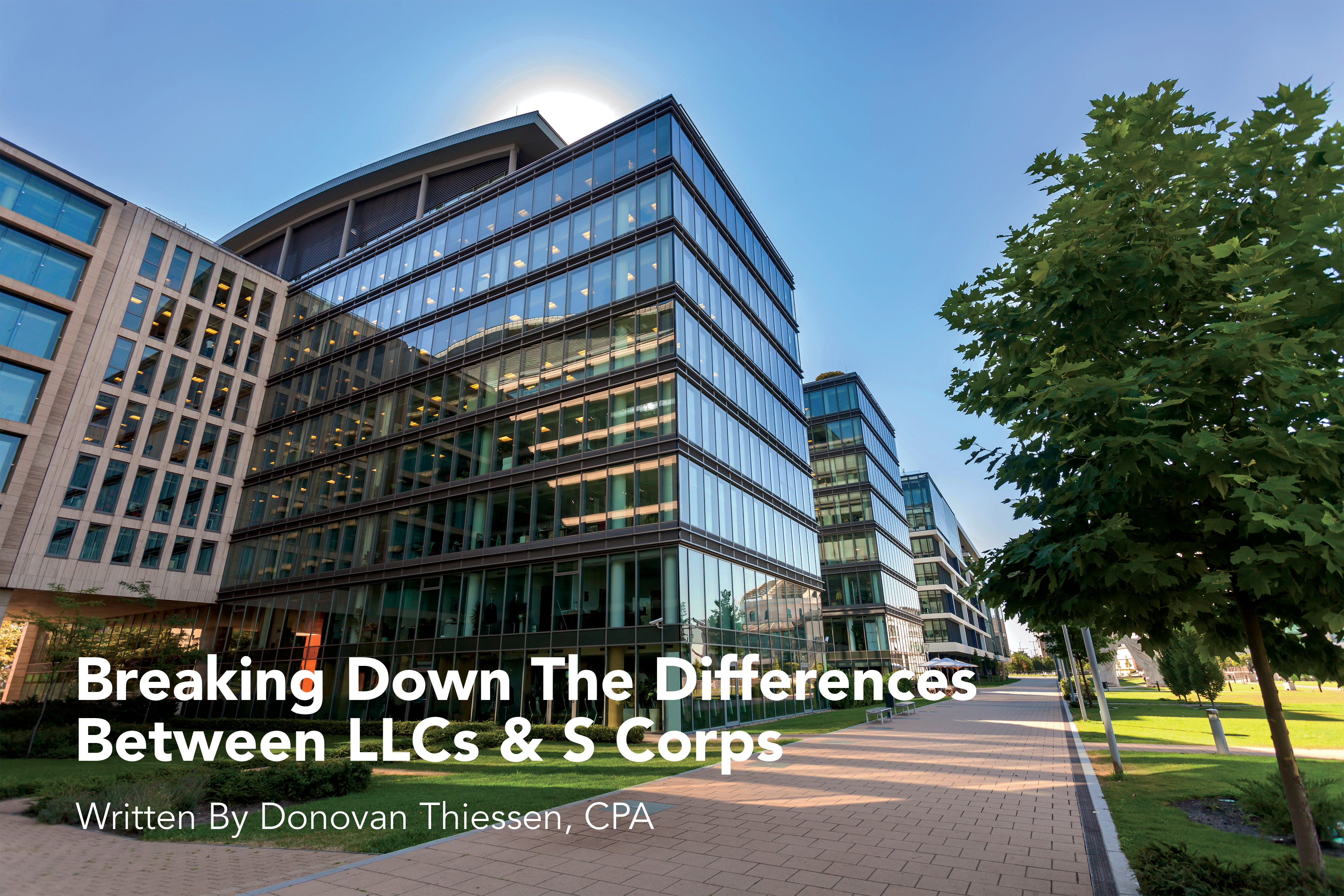 Limited Liability Companies (LLCs) and S Corporations are two popular entity structures for small businesses in the United States. Selecting the appropriate business entity is an early, critical decision for business owners. This article will address the fundamental differences of having an LLC or an S Corporation structure: self-employment taxation, distribution of profits, and the qualified business income deduction.
Limited Liability Companies (LLCs) and S Corporations are two popular entity structures for small businesses in the United States. Selecting the appropriate business entity is an early, critical decision for business owners. This article will address the fundamental differences of having an LLC or an S Corporation structure: self-employment taxation, distribution of profits, and the qualified business income deduction.
Selecting an LLC as their first entity is the most common for small business owners. The owners’ personal assets are protected from the business’s liabilities; they are simple to maintain and have much flexibility for income tax purposes. Let’s look at the income taxation of an LLC taxed as a partnership, where profits are subject to self-employment (SE) and ordinary income taxes. To better understand how SE taxes work, we need to look at salaries for W-2 employees. Those wages are subject to FICA taxes (social security and Medicare taxes). The employee pays a 6.2% social security tax on wages up to $160,200. The employer also pays 6.2% in social security taxes up to that wage base, which is indexed for inflation and increases yearly. In addition, the employee and employer each pay 1.45% in Medicare taxes, not subject to wage limitations. The employer can deduct the FICA taxes paid, whereas the employee does not deduct his or her portion paid.
The LLC pays no salaries to the member (owner) on a form W-2; the profits are subject to self-employment taxes. Self-employment taxes are the same as FICA taxes, except that the owner must pay the employer and the employee portions on their income tax return. This means the social security tax is 6.2 +6.2 = 12.4% and the Medicare tax is 1.45+1.45 = 2.9%. Further, 12.4 + 2.9 = 15.3% in SE taxes. The social security tax is assessed on the first 160,200 in 2023, while the Medicare tax is applied to all income. This tax is in addition to the ordinary income taxes on the same income. A taxpayer with an LLC profit of 130,000 filing as a single individual will pay ordinary income tax in the 24% marginal bracket and the 15.3% self-employment tax. At approximately this income level, it might be best to keep filing under this tax strategy. It might also be an excellent time to discuss the election to have your LLC taxed as an S corporation.
Profits from an S corporation are not subject to self-employment taxes. Before you run out and elect to be taxed as an S corporation, it isn’t simply better for income taxes to be an S corporation. Like the LLC scenario, an S Corporation does not pay income taxes at the entity level; the income is passed through the entity to the owners’ level on their individual income tax return. A key difference is that shareholders of an S corporation that perform services to the company are required to be paid a “reasonable” wage. This reasonable wage is subject to FICA taxes as per the above outline; however, only that salary portion is subject. The remaining profits are subject to ordinary income taxes (not SE tax) and can be distributed from the company to the owner without any income tax consequences. This is how it works under normal situations where you are distributing profits, not loan proceeds, and not funds received for reasons other than profits. As long as you pay a reasonable wage, you can save money on SE taxes. This transition from an LLC to an S Corporation seems to work best around the point where you have $100,000 in profits and they are increasing. As profits increase from this range, so do increased tax savings opportunities. However, it still doesn’t mean that you should run out and do this without further consideration. There are additional considerations for an S Corporation other than tax savings.
Profits and losses (versus property distributions) are also allocated to the owners on a pro rata basis in an S corporation setup. This is a drastic difference from LLCs that allow extreme flexibility for allocating income and losses according to the operating agreement. Again, this concept applies to situations where multiple owners contribute different levels of property and services.
An S corporation can only have one class of stock and no more than 100 shareholders. If you and your spouse are the only members of an LLC, you can treat is as a disregarded entity for income tax purposes and include the income and expenses on your Form 1040 individual income tax return. This contrasts with an S corporation, which requires a separate annual income tax return. Due to the requirement for a reasonable salary, you will also have to start a payroll account that files and pays quarterly payroll, state unemployment tax returns, and an annual W-2 and Form 940 federal unemployment tax return. These additional costs tend to chip away at the potential SE tax savings.
 The most important consideration is the S corporation rule that requires all cash and property distribution to be “pro rata.” This means in proportion to your ownership. In an LLC where you have multiple members that provide varying levels of contribution to the company (cash or services), the LLC can be organized flexibly as to how it pays out profits. It can be set to distribute profits to the LLC member that provides the services to the company and perhaps not to the passive investors, or however you set the partnership agreement. In contrast, any cash distributions in an S corporation must be paid to each shareholder based on their ownership percentage level. Take for instance; you have 3 passive investors in your S corporation, which an aggregate ownership level of 50%. They provide no services to the company except that they contributed property (cash and equipment). If the company has $100,000 in profits and decides to distribute it to the owners, the nonpassive owner would receive $50,000 and the passive owners would receive $50,000. Every time a distribution is made, it must be made according to the ownership percentages. This is a requirement for S corporation, and failure to comply could result in the termination of the S election. The S election might be good for tax savings. However, depending on how your company is organized and the profit distribution method that makes sense for your business, it might be terrible for paying owners in a business with multiple owners.
The most important consideration is the S corporation rule that requires all cash and property distribution to be “pro rata.” This means in proportion to your ownership. In an LLC where you have multiple members that provide varying levels of contribution to the company (cash or services), the LLC can be organized flexibly as to how it pays out profits. It can be set to distribute profits to the LLC member that provides the services to the company and perhaps not to the passive investors, or however you set the partnership agreement. In contrast, any cash distributions in an S corporation must be paid to each shareholder based on their ownership percentage level. Take for instance; you have 3 passive investors in your S corporation, which an aggregate ownership level of 50%. They provide no services to the company except that they contributed property (cash and equipment). If the company has $100,000 in profits and decides to distribute it to the owners, the nonpassive owner would receive $50,000 and the passive owners would receive $50,000. Every time a distribution is made, it must be made according to the ownership percentages. This is a requirement for S corporation, and failure to comply could result in the termination of the S election. The S election might be good for tax savings. However, depending on how your company is organized and the profit distribution method that makes sense for your business, it might be terrible for paying owners in a business with multiple owners.
If the annual income is well beyond the $100,000 level described earlier, you could be leaving considerable tax savings on the table if you don’t elect S corporation status. Or at least don’t elect to be taxed away from an LLC or sole proprietor. I’ve seen situations since 2018 where the taxpayer is not correctly analyzing the qualified business income deduction per IRS code section 199A. This is because if you have qualified business income in excess of $182,100 if filing as single, or $364,200 for married filing jointly, your business must have paid wages during the tax year or else you will be limited or unable to deduct the qualified business income deduction. This deduction is 20% of the business profits. On a business that has $400,000 in profits, this is an $80,000 deduction. There are many limitations and planning that go into this, but if your business didn’t pay wages of at least 40,000 in this example, you might not be able to take this deduction. Last month I saw someone in this position, and it cost him an extra $20,000 in income tax by not having S corporation status and simply optimizing the wages paid for the year. He has the opportunity to change this setup for 2023, so hopefully he makes an appointment to discuss this opportunity.
Whether or not to be taxed as an LLC or an S corporation is a unique decision to each business. The self-employment tax situation is normally a major part of the conversation but there can be other considerations such as distributing profits and Code Section 199A optimization. As is often said, “consult your tax advisor” for definitive information on your situation.
Donovan Thiessen, CPA is the founder and owner of The Accountant, LLC. Our mission is to help business owners make better decisions by providing timely and accurate financial and tax analysis. You may reach Donovan at donovan@theaccounantcpa.com,www.theaccountant.cpa, and 702.389.2727.

Leave a Comment